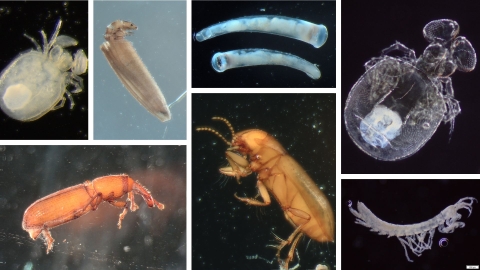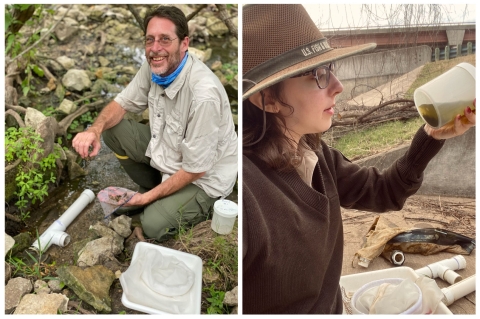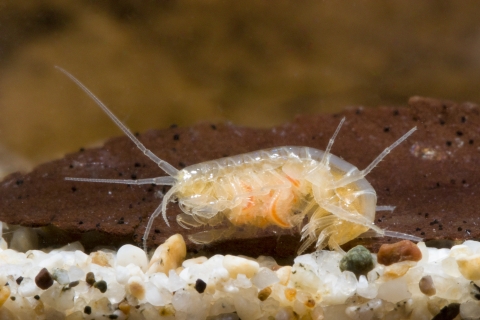In Texas, nine major aquifers hold the groundwater that meets up to 60 percent of the state’s water needs. Within these aquifers and the springs they feed lie some of the most diverse subterranean aquatic ecosystems in the world, providing habitat to a community of cave-adapted catfish, salamanders, and a variety of tiny animals that lack backbones, known as groundwater invertebrates.
Groundwater invertebrates provide a unique contribution to the biodiversity of the state, though little is known about them by most of the general public. But if you look really closely, they resemble other creatures that you might find in your backyard – including snails, beetles and worms.
In addition to serving as a food source for blind catfish, salamanders, and each other, these species can tell us a lot about the health of our aquifers, offering insight into geological and hydrological connectivity and acting as indicators of unsustainable water use and land use practices.
To learn more about these unique creatures, I had a chat with two of the U.S. Fish and Wildlife Service’s groundwater invertebrate experts in Texas. Keep reading to learn about their favorite species to study, how often new species of groundwater invertebrates are being discovered, what these creatures can teach us about aquifers and groundwater connectivity, and the upcoming Texas Groundwater Invertebrate Forum they are co-hosting in late October.
Remarks have been edited for clarity and brevity.
Please tell us about your job with the Service and how you work with groundwater invertebrates.
RANDY GIBSON: My name is Randy Gibson, and I’m a Supervisory Fish Biologist at the San Marcos Aquatic Resources Center. I've been working with groundwater invertebrates for almost 20 years, and I research rare and endangered invertebrates for conservation purposes.
AMELIA HUNTER: I am Amelia Hunter, I work for the Austin Ecological Services Field Office as a Fish and Wildlife Biologist. I work in the listing and recovery branch of our office as the species lead biologist for the Edwards Aquifer invertebrates.
How many groundwater invertebrate species do we know live in Texas? And how often are new species being discovered?
HUNTER:Based on what has been published and what we have in our database,it's safe to say over 100 for sure – and there's new research happening all the time. Every few months I see publications for a new species being described and I'm sure that number will keep going up.
GIBSON: There are many species that are sitting in offices and museums that people have discovered that haven't been described yet, because it takes a lot of time. So there's a backlog of undescribed species already out there.
What are your favorite Texas groundwater invertebrate species to study and why?
HUNTER: I personally like the isopods. I grew up liking the terrestrial ones as a kid and playing with them outside. Once I learned there were subterranean species, my fascination for them grew and so did my questions about what life is like for groundwater invertebrates down there.
GIBSON: I like them all, but the one I specialize in is amphipods. So I’ll make that my favorite. The reason is they're one of the most diverse group in groundwater, there's all different kinds, and they are very difficult to work with. Some are extremely old marine relics and there's a lot you can learn from them.
What can we learn from them?
GIBSON: Some of these are widespread throughout the Edwards Aquifer from Salado all the way out to the Pecos River, and some of these are very isolated. You can learn about the history and the hydrology of the aquifer just by the critters that are there using genetics. It's a tool to map out and understand the age, development, and connectivity of an aquifer.
Have Texas’ groundwater invertebrates been studied for a long time? Or is this a new area of research?
GIBSON: Glenn Longley back in the 80s was the first person to place a net on an artesian well in this area. He put some pantyhose over a spring at Texas State University and collected blind salamanders and many invertebrates new to science.
I started doing groundwater research in this area about 20 years ago. Other folks at universities and some consultants have also started putting smaller mesh nets on springs and we're collecting many new species. So we are on the second wave of discovery. And mainly we're getting all the tiny things that they missed or the rarer species. We are also sampling springs all over Central and West Texas that never been sampled before and finding all kinds of cool critters.
HUNTER: And I’d like to add that [Environmental DNA (eDNA)] is becoming the new technology to detect invertebrates. Whether we don't have access to the land, or the well has been capped, by finding places where we can collect water we can gather information about where and what critters are down there. It's a topic that people have started dipping their toes in and getting more familiar with.
GIBSON: We have recently hired a geneticist who's building a lab to do work like that too, because some of these cave- and groundwater-restricted species are very difficult to collect. They're very rare, and it's logistically challenging to access caves and groundwater. So [eDNA] is a useful way of finding out where the species really are spatially distributed, because they might have a larger geographic distribution than we thought. Many inverts were originally collected at one site, and now we find them distributed throughout the Edwards Aquifer. So it's a matter of trying all the sampling techniques available at multiple locations.
It must be fun studying something where you have no idea what you're going to get when you go sampling.
GIBSON: It's like Christmas. I sampled the Panther Canyon well for a year before I collected a blind salamander. I've also sampled where I'm getting one or two subterranean beetles every week and then after a rain event, no more were collected. Conditions can easily change when it comes to wells, but it's always exciting. You never know when you might find something cool and new.
What are the challenges in studying these species?
GIBSON: They're small organisms, and it's difficult to sample the habitat and access it. We are trying techniques where we're taking a shovel and digging down and looking for them, or hitting a well spike and pumping groundwater out, or just putting nets on springs and hoping that something will incidentally drift out.
The other difficulty is that many of the species look the same. So just trying to figure out what they are is challenging. And there's many undescribed ones, so you must decide if it is a known species or new.
HUNTER: Also range estimation, not having access to everywhere that they can live, or even seeing the habitat is impossible. To what extent underground do they use? How far do they travel the underground streams? Or do they live in the small pore spaces? How deep can they go?
What's the timeframe between finding a groundwater invertebrate and being able to identify it?
GIBSON: It just depends on the critter. The beetles are relatively easy to identify, but the isopds are extremely difficult, and there's only a few people that have the training. There are expert scientists for each taxonomic group, for snails, worms, crustaceans, or beetles. So for some of these specimens, we have to send them off to the one expert. For others, we don't know what they are, and no one studies them. They're just sitting in a vial waiting for someone to take on the challenge to identify them to species, or even determine there is a new species to study.
These species often go unnoticed by the general public. What should people know about them and their role in our aquatic ecosystems?
GIBSON: They're adapted to this relatively stable environment – the temperature and water quality is consistent. We monitor inverts that come out of springs, and if there's a big change in that community there's probably something changing in the aquifer water quality or quantity. It could be potential pollutants or other factors, but it's a way of detecting shifts in the groundwater habitat that might need further investigation.
In Texas, 10 groundwater invertebrates are on the ESA list of endangered and threatened species. What are the primary threats to these species, and what conservation measures can help them recover?
HUNTER: The current listed inverts are mainly subterranean or spring inhabitants, and little is known about the species’ biological needs. What are their tolerance to toxicants? How wide of a range do they live? Are they able to disperse? Those are pretty important for knowing what would make the population resilient. At this time we have to make informed assumptions by applying knowledge of more well-studied species that are similar from other states or even regions.
The most common threats would be anything that could affect the water quality or the quantity of water underground. For springs, conservation measures include ensuring that the water flows freely, having an intact native plant population, and by reducing predators and invasive species invasive species
An invasive species is any plant or animal that has spread or been introduced into a new area where they are, or could, cause harm to the environment, economy, or human, animal, or plant health. Their unwelcome presence can destroy ecosystems and cost millions of dollars.
Learn more about invasive species .
Some places have established conservation preserves to protect these species, but you also need cooperation from other entities and agreements with neighboring private landowners.
Some invertebrates have the establishment of a captive refugia, like the San Marcos Aquatic Resources Center and Uvalde National Fish Hatchery, away from the native habitat. That gives us the ability to research the species and find out what they need to survive and produce offspring, and also ensures the continuation of the species. If there was to be a catastrophic event for the native population, then we at least have the refugia population to reintroduce back to the native habitat.
You are co-hosting the fourth annual Texas Groundwater Invertebrate Forum on Oct. 21. What can you tell us about this virtual meeting and the topics that will be covered?
HUNTER: We thought it would be nice if we could get all the invert researchers and enthusiasts together and share information and collaborate, whether it's discussing research outcomes, or how to preserve things for curation, or for different genetics or sampling methods to be explored.
We used to be a small group – I think the first one was 50 or so people. And now it’s over 100 people, international, and made up of all these experts curious about what we're doing and helping us identify species. Topics we are covering this time are the diversity of species, genetics, recent discoveries, updates on current research projects, and the methods to capture inverts.
TGIF brings together researchers from a variety of institutions to share knowledge about these species. In the last four years, has this increased collaboration made an impact in the overall field of knowledge about Texas groundwater invertebrates?
GIBSON: I think so. Now there's more access to information and places, and we're all talking to each other and sending each other inverts and information. We're able to work with geneticists and other fields of study where we can share information and discover more about our groundwater.
I think it will keep developing and end up being very useful, especially for Amelia and policy folks who make conservation decisions for these species. I think it has made a difference and will keep making a difference.
HUNTER: There's definitely a lot of interest. I think there's been a lot more collecting in the last few years than ever before because of the collaboration and encouragement people get from this forum.
To register or learn more about the Texas Groundwater Invertebrate Forum, visit https://www.eardc.txst.edu/Texas-Groundwater-Invertebrate-Forum.html.








